Foreword
Number… a notion that is proprietary of consumer society, one of the greatest weapons of the media, which is used immorally lots of times in order to deceive customers. We would like to deny it, not take it into consideration, but most of us live under the spell of numbers, even though we don’t know about this most of the times. This is even truer for entertainment electronics products; the amateur consumer believes in numbers, as they seem as a certain base of comparison that always helps making the best possible decision. Or does it?
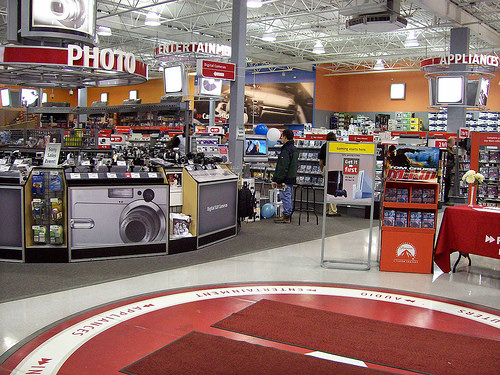
It’s not an easy choice
Although numbers are present everywhere, there effect is even more emphasized on the market of imaging devices. Thanks to digital technology cameras are easy to obtain; something that has been a privilege of a few a hundred years before is something accessible for everyone today. Numbers indicate this very well: in 1996 the number of digital cameras that have been in circulation has been just above one million, while nowadays this value is much over one hundred million. Everyone goes shopping mindlessly; anyone can enjoy the fun of creation, and there’s no problem with that. But unfortunately almost everyone is deceived by numbers: megapixels, ISO sensitivity, optical zoom – based on commercials we can believe that these are enough for photography. But this is not the truth; the numbers do not correlate with important properties and quality. Apart from this, mobile phone manufacturers also like to do the same thing: phone from me, camera from you; probably most of us still remember this kind of slogans. But we, given our profession, do not believe in this, so we went to find out: can a cell phone really replace a digital camera – even if that’s only an entry level one?
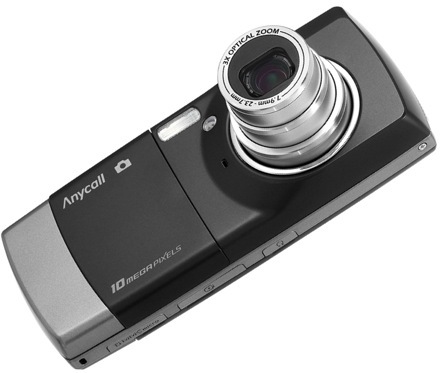
Camera or phone? Both? None?
We would like to answer this question, which might disturb many of you, with our review, so we have taken one of the best camera phones available today (this is Samsung G800), we have also packed three digital cameras, went out to take photos and than we rated the results while keeping professional criteria in view. To understand all this, we have to first understand the concept of photography, the way digital cameras work and some basic concepts, so we’ll discuss these first.
Digital imaging
As probably all of you already know, the base of photography is light, which is the visible range of electromagnetic radiations. We’ll disregard the physical part of it (for obvious reasons) and I’d rather write a couple of things about the nature of light visible to humans. We can describe the color range we can sense with three colors: red, green and blue. If all three of these are present to the same extent, than we see white light, while we sense different shades of colors due the mix of these three colors in different ratios. It’s hard to define white color, as we see a sheet of paper to have the same white color at the light of a candle and under the light of the Sun, which has a roughly balanced radiation in the visible spectrum of light. This is the wonder of the human mind, but a camera cannot adapt to the environment in such a manner and that’s why we have concepts like color temperature (aka white balance). But we’ll talk about these a bit later…

Olympus E330’s cross-section view
So when taking photos we store the light itself: on film in the case of analogue cameras and to the memory card (with the help of a light sensor) in case of digital cameras. This sensor picks up light entering the camera through the lens, which is then passed along to the camera’s processor in digital format (as pixels). It follows from this that these three components (the sensor, the lens and the processing unit) affect picture quality the most. The light sensor has three important qualities: size, resolution, type. The latter one can be CCD-CMOS or CCD-NMOS. These concepts are known as CMOS and CCD for some reason. The difference between the two is in the production technology. CCD is a more complicated circuit, its production costs are higher, but in turn it has greater sensitivity, reproduces colors in better quality and has better line sharpness. CMOS us cheaper to produce, consumes less power than the CCD, and its advantage is the less noise on pictures. CMOS sensors have developed a lot lately, many major camera manufacturers have chosen this from the two – for example Canon lens reflex cameras have this kind of sensor. Based on these, it’s really hard to tell which technology is better. Cell phones almost always have a CMOS sensor, probably because of their lower power consumption and price.

Sensors among themselves
From our point of view, not the sensor type is what’s most important, but its resolution and size. The latter one changes a lot, which is not known by most of the amateur users, but this is at least as important as resolution, as these two make a pair. There has been no problem with this in analogue cameras, the Leica system used a 24 x 36 mm frames, most of the cameras used this, but the manufacturer can save a lot of money in digital cameras by putting physically small sensors in their devices – and they are saving as much as they can! This is sad because the quality of a picture is not given by its resolution, but by the number of pixels in a given area, which results from resolution and the sensor’s size. At a given resolution quality increases in direct proportion to the sensor’s size, so turning this backwards we can say that the less place a pixel (or the diode of the sensor) gets, the worse picture quality is. That’s why the ongoing megapixel war is meaningless, as from two sensors of the same size – supposing they are of the same type and have the same processor – the better one is the one that has less pixels, which is the one with the smaller megapixel number. Of course the sensors themselves are getting more and more advanced, so the quality that needed a physically large sensor a couple of years ago, is obtainable using with a smaller one today. So we can judge picture quality (noise level) and picture dynamics based on how many square microns of place does a pixel get. Below 5-6 squaremicron/pixel we get low quality, noisy pictures, while this number is around 7 and 11 in case of a high-quality camera and above 30 in case of professional cameras. As most of you might have guessed by now, mobile phones have tiny sensors (due to physical limitations), so the size of them is not published very intensely (to say the least) – in practice such information is almost impossible to find out. So increasing the number of megapixels doesn’t necessarily mean increase in picture quality, so the manufacturers resort to not so elegant solutions…
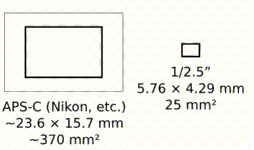
The difference in size between an APS-C from a lens reflex camera and a 1/2.5” sensor from a compact camera
I’ll write about basic photography concepts in short. Those who know what shutter speed or aperture mean can turn to the next page. These are the two things we can use to adjust the amount of light entering the camera when taking pictures; their value can be adjusted in steps of a preset value. Shutter speed is the duration of light reaching the image sensor, while aperture is the diameter of the “hole” in the lens that can be adjusted to control the amount of light reaching the image sensor. The larger the aperture is, and the more it is open, the more light reaches the sensor, this is evident. Setting these two parameters, we can alter some other things besides light quantity: depth of field depends on aperture size and decreasing shutter speed helps avoiding picture blurring due to camera movement, but I won’t go into any more details about these. The amount of light required for a correctly exposed (not too light and not too dark) picture is decided by the automatics of the camera, or at least in entry-level cameras, more advanced ones let us set shutter speed and aperture – in this situation the camera displays how many exposure values away are we from the exposure considered as correct. In case the sensor does not receive enough light, we get an underexposed picture and if it gets too much light, then the picture will be overexposed. There is a third participant in setting this, and this is sensitivity, which is measured in ISO. This can be set from the menu in digital cameras, while analogue cameras needed a different kind of film. More about ISO on the next page. By the way, the measurement is the same ASA/ISO standard we can see on the boxes of films.



Correct exposure, under- and overexposed picture
About image noise...
Let’s talk a bit about noise on pictures, which is one of the specifics of pictures made with digital cameras. We consider image noise every difference in the structure that is between the picture and the clear, ideal view of the theme (or we can also say that image noise is a random, usually unwanted, fluctuation of pixel values in an image). The most significant source of noise in digital cameras is the image sensor, while the difference visible on the picture is due to photon noise, which is given by the statistical uncertainty of the number of detected photons. In the photographical lighting range we can consider light streaming as continuous, but in fact it is not permanent, so no matter the camera measures X photons, that is never the exact number of photons that effectively hit the sensor, and a difference of a few dozens is enough to create image noise. Although noise increases as the number of photons do (the more light it is), but still, pictures taken in good lighting conditions are less noisy than those taken in darkness. The reason for this is that with lighting the number of photons increases faster than the noise itself, so the signal/noise ratio is enhanced, which makes noise become less evident – even though there is more than on a picture taken in darkness. A logical consequence of these is that noise level of cameras with a small sensor is higher, than in lens reflex cameras with a large sensor, since in a smaller sensor a smaller number of photons can be collected. And of course phones have a sensor smaller than even in entry-level cameras…

Picture taken with mobile phone in poor lighting conditions (SE K750i)
Night mode pictures are of lower quality also because of the so called dark noise. A part of the photons getting to the sensor hits an electron, which escapes from the attraction of the nucleus, thus creating a photoemissive effect. The photoelectrons are kept in the pixel by the control electrode’s electric field, and the quantity of the electrons collected this way is measured by the image sensor when it reads information. The problem is that pixels won’t contain only “useful” photoelectrons, but there will be ones created by thermal means, which are the source of dark noise. The number of these increases in direct proportion to exposure time and temperature, and we usually use a longer exposure time in poor lighting conditions, which is also a reason if image noise. By the way, this is quite a poor noise factor in cameras; it is visible only in the darkest areas.

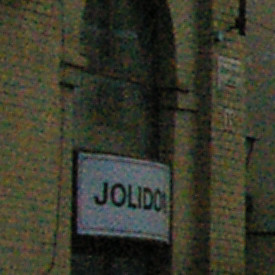
Image noise at ISO200 (left) and ISO3200 (right) sensitivity (Pentax K100D Super)
Considering the topic of our article, it’s not these that are overly important, but noise due to sensitivity changes. As I have already mentioned, we don’t have to insert different kinds of films in order to change sensitivity, it’s enough to press a couple of buttons. There is another great war amongst manufacturers regarding ISO value, even the cheapest devices feature never before seen sensitivities (ISO 12800, etc.), but these are unusable without any exception. That’s because in case of digital cameras setting this value doesn’t alter the sensor’s sensitivity, but only amplifies the signal it produces, before digital-analog conversion. If, for example, we switch to ISO 800 from the base ISO 200 sensitivity, then the signal is amplified four times, and we get the same light level from quarter the signal, so from less electrons at the same time. The only problem is that the signal/noise ratio deteriorates and the amount of dark noise and readout noise increases, even though the latter one is already significant enough. In case of a small image sensor – like the ones in cell phones – the phenomenon is even more powerful, so when using a more advanced camera phone, that supports altering ISO settings, we can only alter the value in a narrow range, but I’m almost sure that the number of wars will soon reach this part too.



Noiseless, noisy, noise-filtered picture
Noise filtering is something also worth mentioning. Manufacturers try to enhance noisy pictures taken with small image sensors with different kinds of filtering algorithms, which usually aren’t very good. There are two wide-spread methods in cell phones: one of them is the one used in Sony Ericsson’s mid-range phones, which although eliminates every noise and artifact from the picture, but in turn it results in a blurred, oil-painting-like photo. Other companies are more discrete, they don’t eliminate image noise completely, just reduce it to an acceptable level, but this still results in smaller details getting lost. Due to some physical limitations of mobile phone they make noisy, filtered pictures, and unfortunately this is a fact, which is a partial answer to the main question of this article…
The cameras, technical data
We have enrolled three digital cameras against G800. The first is Fujifilm’s FinePix A500, an entry-level compact camera, which has been announced more than two years ago. The 5 megapixel camera represents those cameras, present in many households, that are mostly used for recording family events. The second one used, is a more advanced compact camera from Samsung (Digimax S600), which is although just as old as the one from Fujifilm, it still has more features and has manual settings. As for the third we have chosen an entry-level digital single lens reflex (DSLR) camera, which is although obviously not a concurrent of G800, but it’s good to have an example of what a top phone knows compared to a “real” camera. We have used a 18-55 mm kit lens with 3X zoom, which has a larger angle of view than the lens on the compact cameras, but it has a smaller focal distance in tele mode due to this.
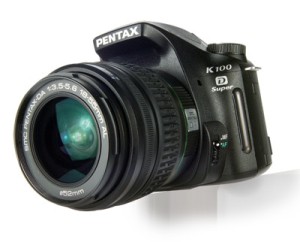
Pentax K100D Super
Comprehending the major specs of the cameras will probably be no problem to anyone, knowing the information from the previous pages. Unfortunately we have no exact information about the image sensor in G800, the manufacturer guards the secret of it very well, as neither the manufacturer, nor the size are known. We suppose that it is a 1/4” CMOS sensor, although some sources say that the phone has a 1/2.5” one, made by the manufacturer.
| Samsung G800 | Fuji Finepix A500 | Samsung Digimax S600 | Pentax K100D Super | |
| Sensor resolution (effective number of pixels) | 5 megapixels | 5.1 megapixels | 6 megapixels | 6.1 megapixels |
| Sensor type | CMOS* | CCD | CCD | CCD |
| Sensor size | 3.47 x 2.78 mm* (9.64 mm2) | 5.7 x 4.2 mm (23.94 mm2) | 5.7 x 4.2 mm (23.94 mm2) | 23.5 x 15.7 mm (368.95 mm2) |
| Square microns/pixel | ~1.8* | ~5 | ~4.2 | ~45.5 |
| Max. resolution | 2560 x 1920 | 2592 × 1728 | 2816 x 2112 | 3008 × 2008 |
| Sensitivity | ISO 50-400 | ISO 100-400 | ISO 50-400 | ISO 200-3200 |
| Focal distance | ~36 - 108 mm* | 38 - 114 mm | 35 - 105 mm | 27 – 82.5 mm |
| Zoom | 3x | 3x | 3x | 3x |
* - unofficial data
G800 is somewhere in the middle between a completely entry-level and a somewhat better camera, based on its features. We can set exposure correction (+/- 2 exposure value), ISO sensitivity and white balance on it, but there are no such settings for shutter speed and aperture. There are lots of theme presets, which is very welcome: portrait, landscape, sport, interior, snow, sunrise, autumn colors, night mode, counterlight, fireworks, text. There are three different resolutions available (5, 3, 2, 1.3 megapixel and VGA), JPEG compression can be set in three steps. Autofocus can be turned off in the menu, which is something I don’t really understand, as we cannot set it manually.

There is 3X optical zoom, that can be further expanded with a 3X digital zoom, and let me skip answering: why? Light metering can also be altered by the user, and the list of functions also includes image sequences, panorama and self timer. Macro mode is set separately; the lower aspis is around five cm. At the flash we can set a pre-flash mode for red eye reduction, but unfortunately the flash itself has a very limited use, no matter the Xenon technology. The reason for this is that we cannot set charge level, and neither does the camera’s software set it, which results in the same power of flash at any distance, so we get a burnt, white picture when we’re close to the theme; I think the ideal distance is about 1-1.5 meters. To tell the truth the Xenon flash doesn’t even give light on a longer distance.
Samsung G800 – noise level, optical properties
Therefore noise level is significant both in compact cameras and in mobile phones. Samsung G800 is no exception: as you can see on the pictures the phenomenon is visible, no matter the sensitivity, so it’s significant even at ISO 50, although it’s not worse than at a usual entry-level camera. At ISO 100 we can observe the traces of noise filtering, which makes the picture become less rich in details, but on the whole we still get a usable picture at such a setting. Setting the sensitivity to 200 or 400 results in blurry photos that are extremely poor in details, thus the use of these settings is not recommended. The result is not as good as in case of an entry-level camera, as G800 can practically create photos of a usable quality only at the lowest sensitivity level.
Rim-obscuration, or vignetting is a usual phenomenon for cameras and its amount is determined by a lot of factors, for example the lens quality, the used angle of view and the aperture – it is the highest at wide-angle mode with a large aperture. This symptom is present at G800 too, but it in not a great manner; it’s not disturbing at all. It’s interesting, however, that in wide angle view the corners do not darken evenly, the effect is the weakest in the lower left corner, and the most powerful in the upper right. The phenomenon is visible in tele view (zoomed) too, even though it’s not at all that powerful. The corners darken evenly in this mode.


Rim obscuration in wide angle and tele view (highlighted with imaging software)
The “lens’” degree of distortion is quite insignificant: there is a slight barrel distortion in wide angle view and a small cushion distortion in tele mode. As wide angle view is not true wide angle and zooming level is small, this is all right. The loss of details in the picture’s corners is not significant, so G800’s lens performs much better from this point of view than the Carl-Zeiss in Nokia N95.
Test pictures – wide angle
And now let’s see the long awaited test pictures! We went out to three places to take pictures in daylight and we also tested macro mode in weak, dispersed light. We have omitted night mode photos intentionally, as we couldn’t fasten G800 on a tripod, since it has no connector.


We set sensitivity to the lowest possible on three of the four tested devices, but unfortunately we couldn’t alter this value at the Fuji, so it set it automatically. We have used the other ones in P mode (program automatics), which means that shutter speed and aperture were set automatically, but we tampered with light metering and white balance; we’ve set the first one to average, while the latter one to automatic. As the small A500 has no such settings, we used it in AUTO mode. Pictures taken with the Pentax have a different aspect ratio from the others and in tele mode we had to use a smaller focal distance due to the kit objective, so there are some differences between the pictures.


Fujifilm FinePix A500 / Samsung G800 (click for full size)


Pentax K100D Super / Samsung Digimax S600 (click for full size)
The noisiest of the four pictures is undoubtedly the one taken with G800, the one taken with the bit old A500 is much clearer. Judging color fidelity is a bit subjective; I again consider the pictures of the Fuji better than the one produced by Samsung’s phone.


Fujifilm FinePix A500 / Samsung G800 (100% framing mask, click for full size)


Pentax K100D Super / Samsung Digimax S600 (100% framing mask, click for full size)
At the next site G800 performed better than the entry-level Fuji camera, which made blurred pictures poor in detail. Both of them fall behind the two, more advanced, cameras from the point of view of noise level.
Test pictures - tele
Next we turned zoom to the max, i.e. we have taken some pictures in tele mode.


Fujifilm FinePix A500 / Samsung G800 (100% framing mask, click for full size)


Pentax K100D Super / Samsung Digimax S600 (100% framing mask, click for full size)
After taking a look at the pictures we can still say that G800 still produces by far the noisiest ones. Of course the lens reflex camera’s pictures have the most details; G800 is beaten by all of them. Exposure, however, hasn’t been okay at all of the cameras; A500 had a very small overexposure, while K100D made slightly underexposed pictures in AUTO mode, only S600’s automation had no errors.


Fujifilm FinePix A500 / Samsung G800 (100% framing mask, click for full size)


Pentax K100D Super / Samsung Digimax S600 (100% framing mask, click for full size)
We have zoomed on the church clock too and G800 took a picture disappointingly poor in details. Here I’ve set an automatic ISO value, but it looks like even though there was bright sunlight, the camera’s software didn’t choose the lowest value (50).
Macro photos, dynamic range, opinion
I have taken the macro pictures in some grim circumstances, from the point of view of the cameras. I didn’t use a lamp to illuminate the objects, the only light source was the sunlight filtering in through the window, and that was quite weak. Given these conditions the automatics of A500 set a wrong white balance, but G800 didn’t miss, which is very pleasing. As for noise level, Samsung’s phone was again the rearguard, and I have to say in Pentax’s favor that I didn’t use macro lens, as lens reflex cameras are not as flexible as their compact counterparts from this point view.


Fujifilm FinePix A500 / Samsung G800 (100% framing mask, click for full size)


Pentax K100D Super / Samsung Digimax S600 (100% framing mask, click for full size)
G800 has a low dynamic range, lower than even Fuji A500’s. The result of this can be seen on any test picture taken on the street as they have a bunt out sky and dark parts noisier than usual.

Heavenly skies… or at least it’s white
After reading through the review, probably most of you have the conclusion that can be written in one sentence: picture quality of cameras in mobile phones is inferior even to entry-level compact cameras. Period. Unfortunately there is nothing to gloss over here; no matter the 5 megapixels, the optical zoom or the Xenon flash they are nothing compared to an € 80 compact camera. Of course this doesn’t mean that these phones are unusable. This quality is appropriate for many users, as for example G800, at 3 megapixel resolution, takes photos with a quite reduced level of noise, which can even be printed and put along to the other family pictures. The point is that we shouldn’t be fooled by marketing, since a mobile phone cannot replace a bit more advanced digital camera and it won’t be able to for a while.

It’s not bad
The reason for this is simple: quality lens need space. Nokia N95 only has the label Carl-Zeiss, but they forgot to mention that the renowned manufacturer’s lens is designed to be used with a 1/8” image sensor, while the phone has a 1/4” one. G800 is again a good counterexample, but rim obscuration shows that there is still room for improvements. Still we should be positive, as cameras in mobile phones have advanced to a usable level in a couple of years, and there are dozens of mobiles commercially available that can make usable photos. And we can only hope that manufacturers don’t want to solve the problem of noisiness with noise filtering and they also realize that higher dynamic range is something good. We curiously await Sony Ericsson C902 with final software and the pictures taken with it. This means we’ll soon be having another review on the topic of photography!
Bocha
Translated by Szaszati
Samsung G800 used for testing has been provided by XXL GSM. The phone can be bought at:
Budapest VI. Jókai tér 6.
Budapest VI. Teréz körút 18.
On-line at www.xxlgsm.hu.














